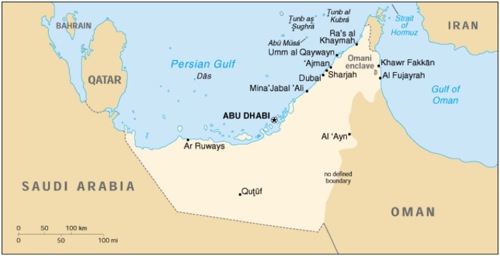
|
About Ras Al Khaimah
|
» About RAK
|
|
Ras Al Khaimah (RAK)
emirate is one of the seven emirates forming the UAE federation.
It is the northernmost emirate, located approximately 100 kilometers north-east
from Dubai to which it is connected by the dual-carriage Emirates Road,
a coastal highway, and by a number of small single-carriage roads. Its neighbors
are the emirates of Fujairah and Umm al Quwain (plus it has a very short
border with the Sharjah emirate in the desert interior) and with the Musandam
peninsula enclave of the Sultanate of Oman. Ras Al Khaimah is the part of
the UAE which is geographically closest to Iran. The Bandar Abbas port in
Iran is only 100 kilometres (60 miles) from Ras Al Khaimah's Mina Saqr Port.
Ras Al Khaimah Investment Authority (RAKIA), a leading service provider of investment opportunities and one stop strategies in its Free Zones, Industrial Parks and Offshor conveniences as well as in Real Estate developments and alternative ventures, has revealed that its newer in Middle East Electricity and Gulfood has generated extraordinary leads in conditions of attracting particularized industries to RAKIA’s Free Zones and Industrial Parks.

Ras Al Khaimah ranks among the smaller emirates of the UAE federation but
it has always had an important position: in the past it was a centre of
traditional shipbuilding and maritime commerce, more recently as a centre
of quarrying, manufacturing and tourism. Since 2003, the government of the
emirate has been pursuing the policy of diversification of the economy,
industrialization and promotion of tourism, investment into education and
public health and by investment into public utilities.
With a renewed drive for development over the past few years, Ras Al Khaimah
has been pursuing the goal of becoming a serious investment destination.
In a few years the emirate could become one of the top tourist draws in
the Gulf thanks to its varied landscape which includes both the coast and
the sand dune areas and the mountainous regions with pleasant wadis in the
Hajar Mountains.
Basic data on Ras Al Khaimah
| Area |
2,478 km² (650 sq miles) |
| Population |
250,000 (estimate) |
| GDP |
11,124 million AED (2006) |
| Per-capita GDP |
46,407 AED (2005) |
| Import |
4,284,000,000 AED (2006) |
| Export |
3,646,000,000 AED (2006) |
| Re-export |
2,450,000,000 AED (2006) |
Government and Politics
Ras Al Khaimah joined the UAE federation in 1972 as the last of the seven
emirates. The ruler of the emirate, Sheikh Saqr bin Mohammed Al Qasimi,
has been in power since 1948. Since 2002, most of the day-to-day political
and economic operations are carried out by the crown prince and deputy ruler,
Sheikh Saud bin Saqr Al Qasimi.
Local government departments in Ras Al Khaimah include:
• Emiri Court
• Law Court
• Land Department
• Municipality Department
• Public Works and Services Department
• Economic Department
• General Accounts Department
• Ras Al Khaimah Oil and Gas Commission
• Ports and Customs Department
• Civil Aviation Department
• Information and Tourism Department
• Ras Al Khaimah Broadcasting Corporation
• Antiques and Museums Department
Economy
Ras Al Khaimah´s economy is not based on oil as it has only small oil reserves.
Its gas reserves are more important but revenues from gas are also of a
lesser importance than in other emirates and the emirate has had to look
beyond its borders to fulfill its demand for gas. As the emirate will never
be a major oil producer, RAKia has instead had to concentrate on developing
its industrial sector.
The Emirate is rich with raw materials such as limestone, clay, quartz and
other minerals. Ras Al Khaimah is unique in the Gulf region as it has a
high concentration of leading industrial units which process these natural
resources and manufacture various types of cement, clinker, ceramics and
other building materials. It opened the UAE's first cement company in the
early 1970s and is now the UAE's largest producer of cement. rakia also boasts
the largest rock quarry in the Gulf region.
In the 1980s, the emirate formed RAK Ceramics, which has become the world's
largest ceramics producer, and Julphar, the Gulf region's first pharmaceuticals
company. As the first pharmaceutical and medical supplies manufacturer in
the Gulf region, Gulf Pharmaceuticals (also known as Julphar) has developed
into a global brand and now sells its products, which meet the rigorous
US Food and Drug Administration and European Commission guidelines, to almost
50 countries.
Since the 1980, other advanced manufacturing companies have set up operations
in Ras Al Khaimah, including companies producing glass, CD and DVD discs,
air-conditioning equipment, machinery parts, metal products and others.
The total number of industrial companies registered in Ras Al Khaimah exceeded
100 in 2006.
More traditional industries, such as fishing and agriculture, continue to
play an important role in RAK's economy. In 1955, the first agricultural
research centre in the UAE was established there, and since then, innovative
methods of arid zone cultivation have made the emirate one of the leading
agricultural producers in the UAE. Ras Al Khaimah is well known for its
dairy and poultry products, eggs, fodder and animal meat. In addition to
this, the fertile plains in the south-east produce fruits and vegetables
for the local UAE market.
Tourism is becoming one of the major industries in the emirate with several
large tourism projects at various stages of completion. Natural topographical
features of Ras Al Khaimah include about 65 kilometres of sandy beaches,
mountains which reach almost up to 2,000 metres, gravel plains and sand
dunes.
Related Link: www.rak.ae
|
|
|
|






